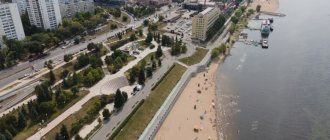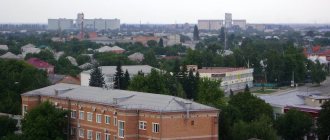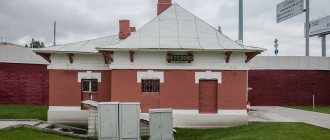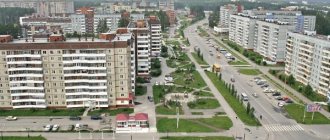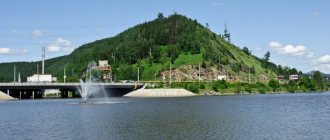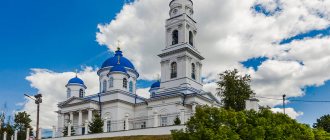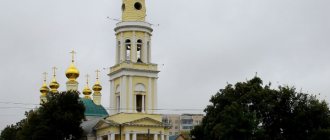| Penza, beginning XXI century |
Penza
, a city in Russia, the administrative center of the Penza region, the cathedral city of the Penza diocese. Population 517.4 thousand (2011)
- On the map: Yandex.Map, Google map
The fortress on the Penza River was founded in 1663 under Tsar Alexei Mikhailovich as an outpost on the southeastern outskirts of the state, which was easy and unprotected prey for the steppe nomads.
In May of that year, Yuri Ermolaevich Kotransky, who was previously the governor of the city of Balakhna, “to build a city,” arrived on the Penza River with a hundred Cherkasy Cossacks. He became the founder and first builder of the city. In a fairly short time, the wooden Kremlin was erected. Responsibilities for creating settlements and fortifications near the fortress were assigned to the voivodeship administration, which was headed from the end of 1663 by the first Penza voivode Elisey Protasyevich Lachinov. By decree of the tsar of October 13, he “built a settlement and settlement in Penza near the city,” that is, he allocated land to the city residents: mounted and foot Cossacks, gunners, and collars. In 1665, the city's population was about 3,300 people (almost 700 households).
For many years, the Penza fortress served as a reliable barrier against the nomads - the Kuban (peoples of the North Caucasus and Azov region) and the Nogai hordes. Penza was attacked by nomads in 1668, 1680 and 1717, but they never managed to capture the fortress. According to legend, in 1717, during the Great Kuban Pogrom, the attackers burned the southern part of the city and had already approached the walls of the fortress, but the Penza residents who were under siege appeared before the enemy army from Kazan with an icon of the Mother of God - a gift from Tsar Alexei Mikhailovich, which saved the city from destruction. The Kazan Icon of the Mother of God is to this day the main shrine of Penza.
In the first third of the 18th century, Penza turned into an internal city of Russia and lost its former strategic importance. In the second half of the 18th century, the Penza region became one of the main areas of landownership in the country. By this time, Penza was a major economic center, the prosperity of which was based on commercial agricultural production (mainly the export of grain) and distillation.
Since 1719, Penza has been the center of the Penza province of the Kazan province. In 1780, the city became the center of the Penza governorship, subordinate to the Kazan governor-general.
On September 9, 1801, Penza was declared a provincial city, being at the same time the center of the Penza district. The governor's residence was located in Penza.
In the 1800s Penza's population was about 13,000 people.
| Penza, view from the cathedral, pre-revolutionary photograph |
In connection with the sharp increase in the administrative apparatus in the provincial Penza, the number of nobles and officials increased significantly, which, together with the opening in the city at the end of the 18th - beginning of the 19th centuries.
educational institutions and its extremely active theatrical and musical life for the Russian province of those years, made Penza a major cultural center. Thanks to the large number of cultural and educational institutions at the turn of the 19th century. Penza was nicknamed “New Athens”. Penza was traditionally located at the intersection of important trade routes, and by the end of the 19th century. received railway access in all directions: on October 11, 1874, traffic began on the Morshansk-Syzran section. This circumstance created good preconditions for economic and cultural development. The epithet of a “merchant” city was firmly assigned to Penza; in the economy of Penza, the leading role belonged to the trade in bread and alcohol and the food industry, especially flour-grinding and vodka.
According to the All-Russian census of 1897, 59,981 people lived in Penza; by 1917, the population was 105,000 people.
On January 3, 1918, Soviet power was established in Penza. In the first post-revolutionary years, Penza found itself in the epicenter of a civil war: peasant uprisings broke out in the villages of the province, and in May 1918, bloody battles took place in the city with the rebel troops of the Czechoslovak corps.
On February 4, 1939, the Penza region was formed. By that time, the city's population was 160 thousand people.
In the first years of the Great Patriotic War, Penza turned into one of the most powerful centers in the country for the production of mortar weapons: on the basis of local and food industry enterprises that existed in the city, equipment from factories evacuated from other cities was deployed.
Where is Penza
If you look on the map where the city of Penza is located, you will find it in the very center of the European part of Russia. Distance from Moscow – 629 km to the southeast. Located on the M5 highway connecting the capital and Chelyabinsk. You can get there from Moscow by train, car or plane.
Penza is located on the Volga Upland. The city stretches along both banks of the Sura, one of the tributaries of the Volga. It is compactly located – it stretches from north to south for 19 km, and from east to west – for 25 km. Penza is located on 7 hills. The height difference can reach 100 m. The southern part of the city is especially high - it is located on the hilly bank of the Sura. In addition to this river, Penza, Penzyatka, Ardym, Moika, Staraya Sura, and Barkovka flow through the city. That's why there are many bridges in the city.
It continues to grow and develop rapidly.
2. It is believed that geographically this city is located in the very center of the European part of Russia.
3. The city of Penza received its name in honor of the river of the same name, on the banks of which it stands. This was a common practice in the past.
4. Penza is among the top 100 most populous cities in Europe.
5. The city of Penza was founded in 1663, so it is considered a young city.
6. The history of Penza began with the construction of a border fortress by order of Tsar Alexei Mikhailovich. Subsequently, the city grew around it.
7. Penza was able to receive the status of a provincial town only in 1796.
8. In Penza in the 18th century, trading was widespread.
9. In Penza, the most popular product in 1910 were kerosene lamps.
PEDESTRIAN STREET IN PENZA - MOSCOW STREET
10. The main attraction of Penza is Moskovskaya Street, which is located in the historical center of Penza. This street is the same age as the city.
11. The ancient streets of Penza fascinate city guests, and the sights and museums are not only impressive, but also have their own history.
12. It is believed that the prototype of the city “N” in Gogol’s play “The Inspector General” was Penza.
13. For lovers of historical tourism, Penza is of considerable interest, as many ancient objects have been preserved here.
“MUSEUM OF ONE PICTURE” IN PENZA
14. “The Museum of One Painting,” located in Penza, was able to take 3rd place in the ranking of all existing museums according to Forbes magazine.
15. Penza became famous for its own underground passages, which connect the Orthodox centers of the town.
16. In 1985, this city was awarded the Order of the Red Banner of Labor for its contribution to the economy of the Soviet Union.
CHURCH OF THE TRANSFORMATION
17. The Church of the Transfiguration of the Lord is considered the oldest building in Penza that has survived to this day. In total, there are more than 30 religious institutions in the city.
18. There is an original design called “Traffic Light Tree” in Penza. This is an analogue of the London tree.
19. Mikhail Yuryevich Lermontov spent his childhood years in Penza.
20. On the first weekend of July every year, the all-Russian Lermontov holiday takes place in the Tarkhany estate, which is located in Penza.
OLD CIRCUS
21. In 1873, the first circus in the Russian Empire was opened in Penza. The first stationary circus in Penza was created by the Nikitin brothers.
22. The circus, which was built in Penza and became the ancestor of all circuses, was equipped with 1,400 seats.
23.The oldest educational institution in Russia is the Penza Classical Gymnasium, where children are still studying.
24. In Penza there is a structure 13 meters high, which symbolizes the friendship of peoples.
25. Records of positive and negative temperatures within the city limits in summer and winter here can be +40.4 and -40.5 degrees, respectively. Thus, the temperature difference throughout the year in Penza can reach slightly above 80 degrees. But this happens very rarely.
26. Among all the land emblems of Russia, the Penza coat of arms is one of the most ancient. The coat of arms of this city was created in 1781. Empress Catherine the Great personally approved the draft Penza coat of arms presented to her. It has been preserved to this day.
27. Founded in 1786, the Penza Public School is one of the oldest educational institutions in Russia.
28. In 1792, the first theater opened in Penza. The first theatrical performance was shown here this year.
29. In 1848, the first Russian hippodrome was opened here. It is one of the oldest in Russia. All the local nobles were his regulars.
30. Equipment for working with oil is produced in Penza.
PENZA PLANETARIUM
31. The Penza Planetarium is unique in that it is located in a wooden building. There is no other wooden planetarium in any other city in the world.
32. In 1938, the first watches were produced in Penza.
33. “Eternal” heart valves began to be produced for the first time in Penza.
34. Residents of Penza are very fond of impressionism and beer.
35. Penza is considered the greenest city in Russia.
BOTANICAL GARDEN NAMED AFTER JUMPS
36. It’s not for nothing that Penza is called the greenest city. There are, indeed, a lot of green spaces here. There are also 3 large botanical gardens here.
37. Also, a huge number of reservoirs are located on the territory of this city.
38.The first gardening school was created in Penza in 1820 on the orders of Emperor Alexander the First.
39. The first monument to Karl Marx was also created in this city.
40. Lenin’s parents met and then got married in this city.
41. The most monstrous fire in the history of the city occurred in 1858. The fire then destroyed more than half of the buildings, but the hardworking townspeople did not fall into despair and rebuilt the city.
42. The noble families of Sheremetyev, Suvorov and Golitsyn were from this city.
EGOR KREED
43. The famous youth singer Yegor Creed and comedian Pavel Volya are natives of Penza.
44. Penza is famous for its 50 athletes who brought awards to the city and became Olympic medalists.
On September 6, 2014, a world record was recorded in Penza - “The most popular dance lesson.” 6665 people took part in the simultaneous lesson.
46. There have never been trams in Penza, but only their prototype - a non-electrified intra-city narrow-gauge railway for passengers.
47. Penza has 10 sister cities. Four of them are located in Russia. These are Mytishchi, Omsk, Tambov and Cheboksary, and six are located in other countries.
48. Penza is hosting its own film festival dedicated to the Russian actor Ivan Mozzhukhin.
49. In 1670, Stepan Razin’s detachment visited Penza with an uprising, and 100 years after that, Emelyan Pugachev entered the town.
50. Approximately 30 large enterprises are located on the territory of this town.
HOUSE-MUSEUM OF THE SURGEON BURDENKO
51. The memory of the surgeon Burdenko in Penza is preserved by the creation of a house-museum dedicated to the life of the founder of Soviet neurosurgery.
52.More than half a million people call the city of Penza their home, and, it should be noted, this house is very interesting and generally good for living.
53. Penza has a lot of greenery, the air is not too polluted when compared with the air in other large cities, and, finally, there is a developed infrastructure.
54.The beautiful city of Penza is a great place to study, work, and, finally, just live here.
55. Numerous financial flows from all surrounding areas intersect in Penza, which also contributes to its well-being.
photo from open sources
Penza map
If you are wondering where Penza is on the map of Russia, you need to look southeast of Moscow. It is located approximately at the latitude of Samara, north of Saratov. Nearby are cities such as Tambov, Saransk, Syzran, Ulyanovsk.
A map of Penza shows that the city is crossed from west to east by the M5 highway, and from north to south by the Sura River. It covers an area of more than 300 km2. Three main streets pass through the center: Volodarskogo, Kirov and Moskovskaya. The latter is notable for being pedestrian. That's why it is also called Penza Arbat.
Penza is a very green city. Almost in the center there is a Botanical Garden and a large zoo. The climatic resort of Akhuny is located nearby. The city itself has many parks and squares, so it is considered one of the greenest in Russia.
Option No. 2
Penza is one of the large cities located in the Central Volga region of our vast Motherland. The city was founded in the 17th century on the banks of the Sura River.
The Penza region is characterized by three natural zones: forest, forest-steppe and steppe. The territory is famous for its picturesque nature and diversity of fauna. The area captivates with its magnificent open spaces and original Russian beauty.
Penza is filled with the spirit of the pre-revolutionary era. Historical architectural structures have been preserved in their original form. One of the main and oldest streets of the city is Moskovskaya. Local residents call it the Penza Arbat. Most of the street is a pedestrian zone. While walking along the promenade, you can see the first two-story merchant houses, architectural monuments, and sculptural compositions.
The Penza land is rich in cultural monuments with which the names of famous Russian figures are associated. Russian poet Mikhail Lermontov spent his childhood in Tarkhany, Penza region. Today, the house is a museum-reserve. A street and park in the city of Penza are named in honor of the great figure, where a monument was erected to the writer. Near the library named after the great playwright there is a sculpture in the form of an open book with the lines of the famous poem “Sail”. The objects of cultural heritage of Russia in the Penza region include the museum-theater of the Russian theater director Vsevolod Meyerhold, a gymnasium, a museum-estate, a park, and a monument to the Russian literary critic Vissarion Belinsky.
The spiritual culture of the Penza region is represented by buildings of the Orthodox faith. The territory is home to majestic temples, blessed churches, tranquil monasteries, and magnificent cathedrals. The Church of the Resurrection of Christ is truly the oldest building in Penza. The founding date of the original wooden building is considered to be 1660 in the Cherkassy fort, which existed before the formation of Penza.
The city is known for its modern, original art objects. One such object is a traffic light tree. The miracle tree contains 36 used traffic lights. The exclusive concept, which has no analogue in Russia, is appreciated by residents and guests of Penza. A creative piece of art guarantees vibrant photographs.
Hospitable Penza is a must-visit to get acquainted with the marvelous and picturesque corner of the Volga region.
Population of Penza
The population of Penza grew rapidly in the 20th century. If by the end of the 19th century it was only 60 thousand people, now the city is in 35th place in terms of population in Russia. It is home to 520,300 people.
The largest number of residents was in 1989 - 542,612 people, and in 1993 - 552,000 people. After this, the population slowly declines. There were small increases in 1996, 1999, and also in 2010-2016. Over the past 4 years, the population has gradually decreased by 4 thousand people.
The city grew at the expense of the suburbs, so the majority of the population comes from rural areas. But the level of culture of the residents is high. Penza has several higher educational institutions, many museums, and cultural events, exhibitions, and festivals. There is still debate about what to call the residents of Penza: Penza residents or Penzyaks. The second word is traditional. But since the 90s, local residents prefer the name Penza residents. This word has taken root in the media and on television.
Popular message topics
In terms of size, the Indian Ocean is in third place after the Atlantic and Pacific. It stretches approximately 9,978 kilometers from southern Africa to the west coast of Australia and is several times the size of the United States.
Aluminum or another less common name, Glinium, is a chemical. element, in the periodic table. Mendeleev is located at atomic number 13, a chemical element of the 3rd group. Aluminum is a light metal
The healing properties of leeches have been known to mankind for several millennia; using them for bloodletting, it was believed that they could cure many diseases. Currently, the use of leeches in alternative medicine
Source
Sights of Penza
Penza is one of the oldest cities in Russia that has preserved the atmosphere of the past. It is worth strolling through the streets of the Old Town and admiring the ancient buildings. The following attractions of Penza deserve attention:
- Meat passage;
- regional drama theatre;
- Sura embankment;
- defensive rampart;
- Trinity Convent;
- People's Observatory;
- Museum of Local Lore;
- a light and music fountain and a cuckoo clock in the park on Moskovskaya Street;
- observation deck on the Kremlin hill;
- Victory Monument;
- Church of the Transfiguration.
Leave your comment
Gift certificates
The Ministry of Health will allow research on Sputnik V on children over 12 years old
Reading time: 1 minute
About 680 thousand graduates will take the Unified State Exam in Russian on June 3 and 4
Reading time: 2 minutes
Every third student is behind in school
Reading time: 3 minutes
The Russian government will consider the issue of providing children with milk in schools
Reading time: 1 minute
The Ministry of Education is preparing a program for the modernization of pedagogical universities
Reading time: 1 minute
Low ability to independently complete tasks leads to learning difficulties
Reading time: 3 minutes
Responsibility for resolving any controversial issues regarding the materials themselves and their contents is taken by the users who posted the material on the site. However, the site administration is ready to provide all possible support in resolving any issues related to the work and content of the site. If you notice that materials are being used illegally on this site, please notify the site administration using the feedback form.
All materials posted on the site were created by the authors of the site or posted by users of the site and are presented on the site for informational purposes only. Copyrights for materials belong to their legal authors. Partial or complete copying of site materials without written permission from the site administration is prohibited! The opinion of the administration may not coincide with the point of view of the authors.
Source
History of Penza
The history of Penza is interesting because the city was started to be built by the Circassian Cossacks in 1663. At first it was a wooden fortress that guarded the southern approaches to Moscow from nomads. Only at the beginning of the 18th century did it receive the status of a city, and by 1790 it became the center of the Penza province.
The city has experienced a lot: Tatar raids, uprisings of Stepan Razin and Emelyan Pugachev. But it developed as a cultural and commercial center. Already at the end of the 19th century there were two gymnasiums, an art school, more than 150 small factories, and a water supply system. Modern Penza is interesting not only for its attractions. This small town attracts guests with its amazing atmosphere, abundance of greenery and friendly residents.
Cathedral
On the central alley of the Mironositsky cemetery there is the Assumption Cathedral. In 1836, there was a wooden church on this site. 63 years later, during a city fire, it burned down. And in 1905, on the foundation of the burnt temple, a stone cathedral with three altars was built.
In 1937 the cathedral was closed, and for eight years it housed army warehouses. From 1945 to the present time, liturgies and church services have been held in the cathedral. They can be attended by tourists and city guests. Since 2000, a Christian school for children and adults and theological educational courses have been operating on the territory of the Cathedral.
Toy railway
Penza Children's Railway, located on the outskirts of the city near the village of Sosnovka, is one of the main attractions. Since 1985, the educational and entertainment children's complex has become a favorite vacation spot for Penza children and city guests.
The length of the ring road is 1.5 km and runs through a forest area where two intermediate stations are located - Pionerskaya and Sosnovka. A special feature is that this narrow-gauge railway is operated by children under the guidance of railway mentors.
Folk Art Museum
Folk Art Museum
Penza
The Penza Museum of Folk Art opened in 1975. Until 1992 it was called the exhibition hall. The exhibition included samples of folk art created in different techniques: knitted scarves made of goat's down, carved and painted wood products, carpets, ceramic dishes, embroidery, artistic forging.
The museum is located in a wooden building from the mid-19th century. Its first owner was court councilor Varvara Zagoskina, a relative of the writer Mikhail Zagoskina. Then the estate was bought by Otto von Einem, brother of the famous confectioner, “chocolate king” Ferdinand Theodor von Einem. After him and until the revolution, the house belonged to the family of the famous Penza timber merchant Stepan Tyurin.
During Soviet times, the building housed an orphanage, a hospital, and apartments for military personnel and their families. In the 1970s, the house was restored and recognized as a monument of wooden architecture.
Penza Art Gallery named after. K.A. Savitsky
Penza Regional Art Gallery named after K.A. Savitsky
Penza
Art gallery named after. Konstantin Savitsky - the largest and one of the oldest museums in the Penza region - opened in January 1892. The basis of the exhibition was a collection of paintings, which was bequeathed to the city by Governor General Nikolai Seliverstov. The gallery was named after him. In October of the same year, an exhibition of the Itinerants opened at the museum. The newspaper “Penza Vedomosti” reported: “... “The Capture of a Snow Town” by V.I. was exhibited. Surikov, “Life Everywhere” by N.A. Yaroshenko, “The Sinner” by V.D. Polenova, “Time of Passion” by G.G. Myasoedov, etc.”
In 1897, the artist Konstantin Savitsky came to Penza. He became the first director of the Seliverstov gallery and art school, which had opened in the city by that time. Boys and girls could study there together. Savitsky invited the sculptor Konstantin Klodt, painters Nikolai Grandkovsky and Pyotr Korovin as teachers.
Konstantin Savitsky headed the art gallery until 1905. In 1955, by decision of the Presidium of the Supreme Soviet of the RSFSR, the museum and school were named after him. An entire section of the exhibition is dedicated to the artist’s work. Also in separate rooms are works by Ivan Goryushkin-Sorokopudov and Aristarkh Lentulov. Both painters were born in the Penza region.
The museum's collection includes works by Ivan Shishkin, Alexey Savrasov, Mikhail Vrubel, Ivan Aivazovsky and other Russian artists of the 18th–20th centuries. Also here you can see a valuable collection of paintings from the 17th century, created by masters from Holland, France, and Germany.
Museum of Ilya Ulyanov
Museum I.N. Ulyanova
Penza
The museum, which occupies the former service building of the Noble Institute, is dedicated to Vladimir Lenin’s father, teacher and public figure Ilya Ulyanov. On the ground floor of the building there is a permanent exhibition “Ilya Nikolaevich Ulyanov in Penza and his entourage.” Here you can see books of the 19th century from the institute library, original furniture of that time, and personal belongings of Ulyanov. Museum guests will also learn about the teacher’s scientific research, and about the people who surrounded him in Penza - his students, colleagues, friends.
The entire second floor of the building is occupied by the exhibition “The World of the Penza Estates: Family and Life of the 19th–20th Centuries.” It tells about the daily life of nobles, officials, merchants and commoners. Here viewers can see the traditional furnishings of a peasant hut, furniture from a noble living room, and the vestments of an Orthodox priest. The exhibition is accompanied by audio recordings of ancient Penza songs.
Center for Theater Arts "Meyerhold House"
Center for Theater Arts "Meyerhold House"
Penza
The Center for Theater Arts in Penza became the first memorial in Russia and the world dedicated to Vsevolod Meyerhold. It opened on February 24, 1984 in the house where the famous theater director lived.
Exhibition “Meyerhold. Chronicles" is dedicated to the life and work of Vsevolod Meyerhold. Here, museum guests can see rare photographs, letters, texts of plays with notes from the director, and his personal belongings. The rooms have preserved original furnishings: a piano, an antique secretary, Viennese chairs. Costumes that were created for Meyerhold's productions are also on display here. The world's first monument to the director was erected in the courtyard.
The Theater Arts Center includes the Dr. Dapertutto Theater. His troupe consists only of men - professional actors who sing and play musical instruments live, and use elements of choreography, plastic arts and acrobatics in their performances. The concept of the theater was born from the statement of Vsevolod Meyerhold: “Theater is a fantastic spectacle, scenery, masks in the literal and figurative sense, grotesquery, stage metaphors and refined body plasticity.” “Doctor Dapertutto” is the pseudonym of Meyerhold himself. The director took it from the fairy tale “Adventures on New Year's Eve” by Ernst Theodor Amadeus Hoffmann.
How to get to Penza?
Where is Penza located? We have already found this out. How to get to the city from Moscow? Depending on your financial capabilities, you can get to Penza by choosing one of three options.
You can use the services of airlines. Planes depart from Domodedovo and Vnukovo and land at Bolshoye Savino International Airport 1.5 hours later. The ticket price is approximately 7,000 rubles.
The Moscow-Orsk and Moscow-Penza trains arrive at the main railway station of Penza.
Trains depart from Kazansky station. And they arrive in Penza in 14-15 hours. The ticket price will cost 1,150 rubles (reserved seat) or 1,810 rubles (compartment).
In Moscow, three bus stations (Kazansky, Shchelkovsky, South Gate) send long-distance buses from Moscow to Penza. Travel time is approximately 14-15 hours. Ticket price starts from 1200 rubles.
Pokrovsky Bishops' Cathedral
Where is the bishop's cathedral located in the city of Penza? On Chkalova Street. Tourists pay attention to the beautiful religious building, which is called the Penza Intercession Bishops' Cathedral.
The first wooden temple structure was built after the formation of the city itself in the Starodragun settlement, in which a voluntary equestrian Cossack squad was formed (now this is the area of Kalinin Street).
In 1680 the temple was burned, but 7 years later it was restored. At that time, the Vladimirov Icon of the Mother of God was preserved in the church, in honor of which another church building was erected nearby.
In 1765, a stone temple was built on the site of these two wooden churches. It has survived to this day. In 1931, city authorities banned church services. Then the temple was closed, and the premises housed a cinema for a long time.
After 58 years, the building was returned to the Penza church leadership. Restoration work began in 1990. In 1998, the cathedral was consecrated, and daily church services began on October 14.
Project on the theme “My hometown is Penza” for 2nd grade
Goal of the project: As part of studying the subject “The World Around You,” talk about your hometown, its attractions and memorable places.
Find information about his story and share it with your classmates. Tell schoolchildren about Penza and why I love it. Prepare a report and presentation in the form of a photo story. Project plan:
- Location on the country map.
- History and symbols.
- Penza in the present.
- Attractions.
- Places of military glory.
- Conclusion.
- An example of a finished photo story-presentation.
